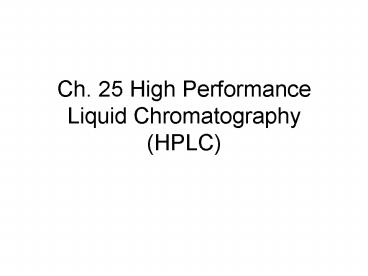Ch' 25 High Performance Liquid Chromatography HPLC PowerPoint PPT Presentation
1 / 12
Title: Ch' 25 High Performance Liquid Chromatography HPLC
1
Ch. 25 High Performance Liquid Chromatography
(HPLC)
2
HPLC
- In HPLC solvent at high pressure is forced
through a column to obtain a separation - The instrument is made of a solvent system, an
injection valve, a column, and a detector
3
HPLC Process
- Diffusion is much slower in a liquid than gas
- Open tube columns are generally not used in LC
because it takes too long for solute to interact
with stationary phase on the sides of the column - In packed columns, the particle size used affects
the separation results - Particles are typically 2-10 ?m
- Smaller particles provide better resolution
because they reduce terms A and C in the Van
Deemter equation and
4
Effects of Particle Size
The optimum flow rate is faster for smaller
particles because diffusion between the mobile
and stationary phases takes place over a shorter
distance than with big particles
5
LC Column Design
Columns are steel or plastic and are
typically 20 cm in length with a diameter of a
few mm. A guard column is used to protect
the main column from impurities and dust. This
column contains the same stationary phase as the
main column. The column is usually
kept heated a few degrees above room temperature.
Decreased viscosity at high temperature reduces
the pressure needed to push solvent through the
column, so retention times are reduced.
6
The Stationary Phase
The most common support is porous particles
of silica with a stationary phase bonded to the
surface. Octadecyl (C18-ODS) is the most common
stationary phase. Isobutyl groups are used to
protect Si-O bonds from hydrolysis.
7
Adsorption Chromatography
Solvent molecules compete with solute molecules
for stationary phase sites in adsorption
chromatography. When a solvent displaces solute,
the solute is eluted from the column. Eluent
strength (e) is a measure of the ability of a
solvent to displace solute from a give adsorbent.
8
e For Solvents on Silica
We refer to use of a polar stationary phase
(e.g. SiO) and a less polar solvent as
normal-phase LC. The more polar the solvent,
the higher the e. Reverse-phase LC is more
common. In this case the solvent is more polar
than the stationary phase.
9
Elution Conditions
- Elution can be performed isocratically or with a
gradient - Isocratic elution is performed with a constant
solvent (pure or constant mixture) - In gradient elution the solvent mixture is
altered during the run if one solvent is not
satisfactory - In a reverse-phase separation, the solvent is
made gradually more polar (higher e)
10
Isocratic Elution
Mixture of acetonitrile and aqueous phase buffer
solution (KH2PO4)
Separation of aromatic compounds, including
alcohols and ketones.
11
Gradient Elution
Increasing ratio of acetonitrile during the
analysis behaves like temperature programming in
GC
Segmented gradient diagram
12
LC Flowchart
The selection separation procedure is governed by
what the analytes are.

